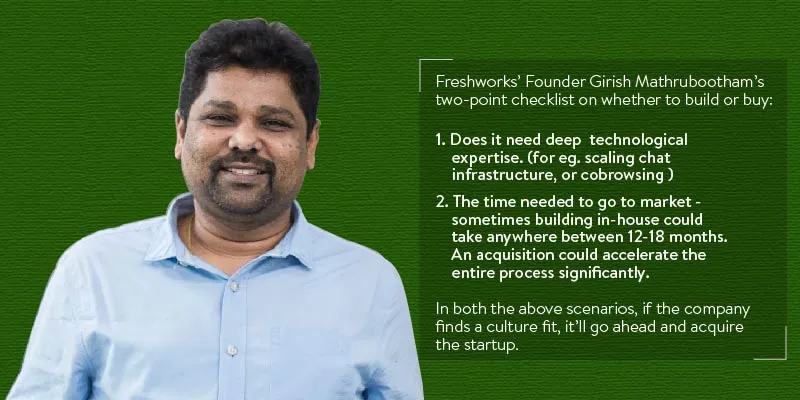Product evolution: how can you get it right?
Increasing competition, reduced customer loyalty and pressure on margins have made time-to-market more crucial over the last few years. Companies and startups must put in place a clear product evolution strategy and road map.
What does an ideal product evolution cycle look like? How do you decide whether to acquire a product or develop from scratch? What does it take to develop and launch a new product? And what can make a company's product strategy a disaster? YourStory spoke to some successful product companies and experts to bring to you the ultimate guide to get your product strategy on track with the help of some current examples and case studies.

Case 1
In October 2016, to scale its chat infrastructure, Freshdesk (now Freshworks) acquired Bengaluru-based social chat platform Chatimity. However, the company took a different approach (of not acquiring a startup) to build its CRM solutions. After struggling for a while with different tools, Freshworks decided to build its own solution and launch it.
Question 1 Why didn’t Freshworks acquire a CRM solutions company?
Question 2 Why did Freshworks not build its chat infrastructure from scratch?
Case 2
In December 2016, Practo acquired Bengaluru-based startup Enlightiks to form the Analytics Business Unit within the company. The company had in September 2015 acquired Insta Health to foray into medical records and management. Interestingly, Practo decided to build its online medicine delivery from scratch.
Question 1 - What stopped Practo from acquiring an online medicine delivery startup (like in the two previous examples)?
Question 2 - What did it take to launch an e-commerce portal (and other products built in-house)?
A “one-size-fits-all” approach can’t be used to answer these questions.
Right from the MVP stage, a product is shaped according to the customer (or client) needs and goes through alteration, expansion and even shutdown based on market forces. But in the process of evolution, it’s important to keep your product strategy on track.
Shrinath V, Google Developer Expert (Product) and Product/Marketing/Design thinking Consultant and Trainer, says,
I don't think there is an ideal evolution as every business context is unique. Products evolve differently due to market factors, current incumbents, market maturity and competition.
Related read - Technology Catch-22: Engineering the product on day 1 to handle hyper-growth in the future
Product development – like a boss!
Thousands of new products go live every month, but creating a profitable product requires a combination of successful product development, launch and management through its lifetime.
A typical new product development goes through the following steps:
- Ideas: to identify the problem and suggest solutions.
- Research: to choose the best solution based on market requirements.
- Development: to design the MVP.
- Testing: to check for the viability and bugs.
- Analysis: to put pricing and marketing strategy in place.

Girish has always dreamt of building Freshdesk (now Freshworks) as a multi-product company. However, Freshworks targeted to win with one product before stepping into multiple options. Girish says, “We picked customer support software, because we knew the market potential and there was a clear need for a better product.”
Over time, the company observed that a sizeable amount of its customers were actually using Freshdesk to manage their internal IT support. This presented Freshworks with an opportunity to build Freshservice for ITSM. Girish adds,
Freshsales was born out of the need to solve an internal problem that we, as a fast growing startup, faced. Our high-velocity sales team found it hard to use existing CRM tools that needed to be integrated with multiple other softwares. So, we decided to build our own CRM so our sales team could forget those problems and focus on selling.
This is a conceptual solution where the company developed the product to primarily satisfy project requirements.
Shrinath believes firms should spend more time on designing conceptual solutions instead of launching a product and then trying to sell it to customers.
Building philosophies
Practo, meanwhile, believes that every aspect of the product should be centred on the consumer. The company’s spokesperson says, “Firstly, from a positioning standpoint, the product should be able to convey what the brand’s core value. At Practo, our core brand value of ‘patient first’ stems from this core insight that healthcare must be centred on the patient.”
Shrinath has seen that people underestimate the complexity of growing and sustaining product lines. Once you have a set line, companies need to evaluate the business case for product extensions.
“The best bet for product evolution is to have a constant watch on the market and its evolution. Keep a living business case which outlines market movements, competitive changes, business opportunities and product evolution,” he says.

While this is usually done by the strategy team in larger firms, the product/marketing team should take care of this in smaller firms. Shrinath believes it's better to do a more realistic evaluation and then decide on committing for development.
At Freshworks, when a team starts to build a new product, it essentially functions as a “startup within a startup”. This way, it can iterate fast.
Girish Mathrubootham, Founder and CEO of Freshworks, believes that the company ensures that they implement the learnings (be they product, engineering, or market strategy related) from previous products to the subsequent products.
Cost effective production and the right distribution channel increase the odds of your success.
Related read - Three main reasons why your product fails to sell
Product launch – getting it right
Launching a new product requires a significant investment (of time and resources) and understanding.
According to ProductLifeCycle Stages blog, “Any investment in research and new product development has to be weighed against the likely return from the new product, and an effective marketing plan will need to be developed to give the new product the best chance of achieving this return.”
Shrinath feels founders who are engineers underestimate the amount of work “downstream” to launch a product. He says,
A lot of work goes into the product marketing side of things - positioning, understanding ecosystem and partnerships, planning communication, interacting with agencies for collateral, managing communication inputs, deciding pricing, channels and margins.
Practo believes that communication plays an extremely crucial role in building a brand. The company wanted to ensure that healthcare should be spoken about in way that is perceived to be approachable. Hence, its inaugural campaign - Life Mein - focused on its “patient-first” approach.
Shrinath emphasises on the importance of skills sets. “Product marketers also need to have a keen understanding of users and buyers, and should be able to craft communication that appeals to both. This is a skill that's sorely lacking with most startups in India as many are not even aware of its importance.”
Product evolution vs pivot

Avnish Bajaj, Co-Founder, Managing Director and Managing Partner at Matrix Partners India, shares the story of how Ola came into existence and shows how a pivot can be a result of product evolution.
After starting as inter-city service, Bhavish Agarwal was quick to identify the opportunity of pivoting to an on-demand intra-city cab service.
Similarly, Avnish believes that Myntra’s pivot from online customised merchandize store to an online fashion store was a part of product evolution as well.
According to Ashish Kashyap, Founder and CEO, ibibo group,
Pivot is a change in product offering, business models, market segment and even customer segments. Product evolution, on the other hand, is a constant improvement and change in the delivery of the value to the end consumer. It’s almost like a co-creation between the company and their customers.

He believes that it is critical to build a beautiful feedback loop between the customers and the platform to make sure that the product evolution is going in right direction. He adds, “A solid start-up will always have a never-ending product development pipeline but with a well thought-out roadmap.”
Shrinath, however, considers pivots as acts of desperation and believes that it usually means that your initial strategy was not right, and people have lost hope on the product/solution. He says, “Most firms do not spend time reflecting on the new area they want to target after the pivot, and are likely to make similar mistakes.”
To build or to buy?
Before addressing the question of whether to build a product or buy a solution, a company needs to figure out whether it needs a new product and also what goes into the launch of a product.
Girish considers the following two questions as check points to decide whether to acquire a company or to build a product from scratch:
- Does it need deep technological expertise (for eg. scaling chat infrastructure, or co-browsing )?
- What is the time needed to go to market? Sometimes, building in-house solutions could take anywhere between 12-18 months. An acquisition could accelerate the entire process significantly.
In both the above scenarios, if the company finds a culture fit, it’ll go ahead and acquire the startup.

While making minor product acquisition, Practo has developed all its major products from scratch. It preferred to keep things that way. For example: Practo Ray- cloud based practice management software was built from the ground up based on feedback from doctors. It sees acquisitions as an opportunity to work together and collaborate with some of the most innovative companies in the healthcare tech segment. For example, in the past, the acquisition of Qikwell helped Practo to develop Practo OPD SaaS that connects large hospitals with its marketplace. With the Insta Health acquisition, the company could provide a full HIMS solution to hospitals.
Apart from taking away the pain of building a product, acquisitions give the ability to scale up in a fast way. However, this approach can backfire as well. Facebook benefited a lot by the WhatsApp acquisition in terms of growth and WhatsApp continues to grow even today. On the other hand, News Corp acquiring MySpace for $580 million didn’t go well and eventually it was sold at $35 million after three years.
You may also like - A survival guide for early-stage product managers
What can go wrong?
In many cases, it's usually a bad understanding of the market, customers and the product's role in the scheme of things that proves to be fatal for the product (and the company at times).
Shrinath says, “It's easy to get seduced by technology and build features that no customer can use, but which needlessly complicate the product and stall its natural evolution.”
Facebook Home, launched in 2013, had to eventually shut down as it ended up consuming a lot of data and battery of smartphones. Microsoft Zune, which was launched to compete with iPod couldn’t generate much interest among consumers. One of the most valuable brands of the world, Nokia suffered massive losses when it couldn’t adapt itself in the smartphone market. The choice to go with a Windows operating system didn’t prove helpful either. The company, once valued at over $300 billion, sold its mobile phone division to Microsoft for merely $7.6 billion.
Shrinath believes that Ola food delivery showed a lack of understanding of factors like the high cost of transporting food to the customers' house using a car (and compared to a two-wheeler). With the longer time taken, it resulted in poor productivity.
He says, “Customers hate waiting for food, so delivery would have to be higher priority than new business - the reasons go on. It's good that they shut it down quickly.”
But not all businesses learn on the go at this pace. The trigger point to decide on scraping a project/product decides the fate of the company.
A product is like a fingerprint. It’s unique to a company, market and users. As mentioned in the beginning, a “one-size-fits-all” philosophy may not work in the case of defining an ideal product strategy. But one thing which stands true for all is that the farther you go from the consumer, the worse it is for the product. So, stay closer, stick together, become a habit. Look around you. All the successful products have that in common.
Have you got your product strategy right? Was this article helpful? Please let us know in the comments below.







